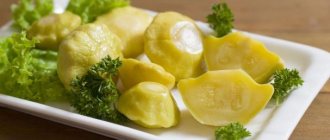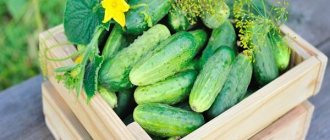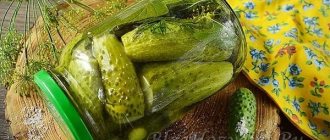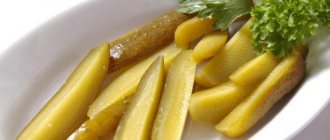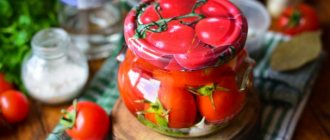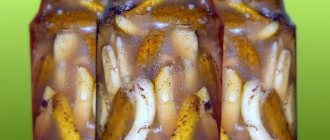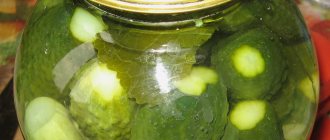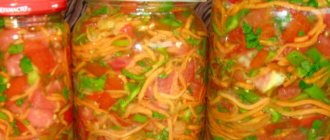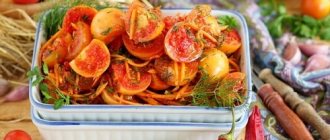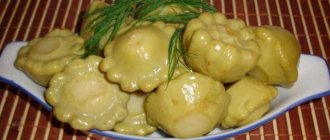Every housewife who makes preparations for the winter has her own recipe with a secret ingredient so that cucumbers remain strong and crispy after cooking. Cucumbers with vodka are salted and pickled for the winter just for this purpose. The taste of alcohol is not felt, and the shelf life increases.
The crunch of pickled or pickled cucumbers will exceed all your expectations. Such preparations are suitable for preparing salads, or as an appetizer for the main course.
Pickled cucumbers with vodka for the winter in jars using the cold method: without sterilization
Let’s put into practice the simplest recipe for pickling with vodka. For containers, we will take three-liter jars, well washed and sterilized over steam or in the oven. Cucumbers, cold-salted in jars for the winter, acquire a pronounced crispness and rich taste with vodka.
What should we take:
- Cucumbers - any size (we will put the same size in jars);
- Spicy additives: horseradish, currant, canupera leaves, dill umbrellas, celery sprig, garlic, peppercorns (black, white, allspice);
- Table salt – 3 tbsp. l.;
- Well or purified water - 3 liter capacity - about one and a half liters;
- Vodka - a shot glass (50 g) per jar.
Let's prepare glass containers, nylon lids, a deep basin and a towel.
- Rinse the cucumbers, place them in a basin, cover with cold water, and leave for three hours. Then dry them on a towel, cut off the ends and sort them into jars.
- Peel the garlic, rinse the greens and leaves and dry.
- Place half of the spices on the bottom of each jar, then a layer of cucumbers (it’s easier to place them vertically), then again spices and cucumbers. Add vodka, salt and fill the jar with cold water to the top.
- Cover with nylon lids and store in a cool place.
After 3 or 4 days, our cucumbers should be salted and they can be tasted.
Cold pickled cucumbers should be stored under nylon lids in a cool place.
And in this video there is another recipe - using the hot method under an iron lid:
Here's a collection of useful tips: when salting and pickling cucumbers, the quality of the water used is of great importance; chlorinated tap water can ruin all the preparations and turn the cucumbers into a soft mess, so use either purified or well water.
We take the simplest salt for pickles, not extra-class and not iodized, and, especially, without anti-caking agents (E-535 and E-536), which are the strongest poisons - sodium and potassium ferrocyanides.
Another recipe: 5 recipes for monastery-style cucumbers, pickled in jars
Treatment process and disinfection
Why are grains processed? They may contain harmful microorganisms, which pose a high risk of plant disease. As a result, the crop yield is greatly reduced.
Disinfection and processing of planting material. The most common methods.
These include:
- Processing using thermal parameters . Viruses and various diseases are the main enemies of cucumbers. In order to avoid their occurrence and development, the material must be heated. Only in this case does the parasitic malicious system die. And taking into account the fact that a warm environment is favorable for the crop, this will also have a positive effect on the germination of grains. If we talk about sowing at home, then for such purposes the most optimal method is using boiling water. To do this, the material for sowing is placed in a thermos. After which boiling water is poured into it. The thermos must be wrapped in gauze.
- The wonderful properties of potassium permanganate . A solution of this crimson-colored powder is indispensable in the process of dressing the grain mass. To prepare it, you need manganese (no more than one gram per half glass of warm water). Don't let the dark, almost black color bother you. If you prepare a weak consistency, there will be practically no effect. Before starting the processing process, be sure to do the following. Carefully separate one grain from another. This is done in order to be one hundred percent sure that all the seeds will be treated properly. Then they are poured onto a gauze cloth, which is placed in the prepared solution. They should stay there for about twenty minutes. Then they are thoroughly washed with water. The water is pre-boiled and cooled to room temperature.
- Two or three percent hydrogen peroxide is an excellent pickling agent. The prepared solution is preheated to a temperature of forty degrees. It is enough to keep the grain mass in it for about eight minutes.
- Useful properties of boric acid . Disinfection is carried out using a solution, the preparation of which requires mixing half a teaspoon of boric acid with a glass of water. It is important that the water is not cooler than twenty-five degrees. The material for sowing must be kept in the liquid for about two or three hours. Then you need running water. The grains must be thoroughly washed. But damage to the peel when treated with chemicals has a detrimental effect on the seedlings.
Cucumbers with vodka for the winter - a reliable pickling recipe
To prevent cucumbers with vodka in jars from exploding, the winter pickling recipe should include a hot pouring step, which interrupts the fermentation process of the brine.
What should we take:
- Cucumbers – small or medium in size;
- Spicy additives: oak, cherry leaves, dill umbrellas, garlic, black peppercorns, allspice,
- Table salt – 3 tbsp. l.;
- Purified water - 3 liter capacity - approximately 1.5 liters;
- Vodka - a shot glass (50 g) - for each jar.
Let's prepare glass containers, lids, a seaming machine, a towel, oven mitts, and a basin.
- Wash the cucumbers and soak them in a basin for 3-4 hours in cold water. After soaking, dry them on a towel and trim the ends.
- Wash and dry the greens and leaves, peel the garlic, cut the cloves lengthwise into quarters. At the bottom of each jar we place half the spices, a layer of cucumbers (vertically), again spices and cucumbers.
- Pour salt, add vodka and fill the jars with cold purified water. Cover with lids and put in a dark place.
- After 3 days, the cucumbers will change color, the brine will become cloudy and covered with a film. Carefully pour the brine into the pan and boil. Add vodka to each jar and pour boiling brine over the cucumbers.
Seal the containers with lids, turn them upside down, wrap them up and leave until cool.
The process of soaking seeds in vodka
Typically, carrot, parsley, celery and dill seeds germinate very poorly. Therefore, it is necessary to carry out pre-sowing seed treatment. To do this, the seeds need to be soaked in vodka. Place the seeds in a gauze bag and soak in vodka for 15 minutes.
During this time, most of the essential oils that cover the seeds dissolve. Then you need to rinse the bag of seeds several times in running cool water. After this, dry the seeds and sow as usual.
Cucumbers pickled with vodka for the winter without sterilization
Recipes for crispy cucumbers for the winter with vodka are becoming increasingly popular due to their ease of preparation and reliability. With vodka you can prepare not only pickled cucumbers, but also pickled ones; they turn out just as crispy and tasty. Using this recipe, you will get blanks that never explode and are stored for a long time without loss of quality. For work, take liter jars.
What should we take:
- Cucumbers are small, young and pimply;
- Onions – medium-sized bulbs;
- Salt, sugar - 2 tsp each. for each container;
- Vinegar 9%, vodka – 1.5 tbsp. l. for each jar;
- Spices and herbs: currant and cherry leaves, a sprig of celery, mustard seeds, hot red pepper - half of the smallest pod, garlic bulbs - they are formed at the end of the garlic stem in the form of small heads.
Let's prepare glass liter containers with threads on the neck, lids for them, a saucepan, a towel, and a basin.
- Rinse the cucumbers, pour cold water in a basin for 3-4 hours, wash, dry on a towel, cut off the ends. Peel the onions and cut into thin rings, wash the greens and leaves and dry on a towel.
- Let's fill the jars: put spices, herbs, half the leaves and one garlic head with bulbs at the bottom. Fill the jar up to half the volume with cucumbers, add onion rings, cucumbers again, and cherry and horseradish leaves on top.
- Boil water in a saucepan and carefully pour boiling water into the jars. Let it stand for 10 minutes, add water to the pan and repeat the procedure - fill the jars with cucumbers a second time, let it stand, and add water for the third boil.
- While the water is boiling, add salt, sugar, vodka and vinegar to each jar. After the third filling, seal the jars with lids, turn them upside down, wrap them up and let them cool.
Another recipe: Cucumbers in their own juice: 8 delicious recipes for the winter
These cans can stand for a very long time without exploding or becoming cloudy.
Sweet and sour pickled cucumbers “Globus” in a 3 liter jar
Remember those same cucumbers like in stores during the USSR? They were called "Globe". I think this unforgettable sweet and sour taste is impossible to forget! Now I will offer you this recipe!
Ingredients:
- Horseradish root
- Dill umbrellas
- Currant casting
- Garlic – 8-10 cloves
- Black peppercorns – 15-20 pcs.
- Allspice peas - 3-4 pcs.
Marinade for 1 liter of water:
- Granulated sugar - 4.5 tablespoons
- Nine percent vinegar – 145 gr.
- Salt – 2.5 tablespoons
Preparation:
1. I pre-soak the greens overnight in ice water. If I plan to preserve in the evening, I fill them in the morning. If possible, the water should be changed periodically to keep it cold at all times.
2. If the jars are new, just wash them with soda and then rinse them well. It is better to sterilize previously used ones - it will not be superfluous. Pour boiling water over the lids for 5 minutes.
3. Place all the prepared greens at the bottom of the cooled containers. Instead of dill umbrellas, you can easily take young green branches. We also add garlic, peeling it and cutting it into large pieces.
4. If you are sure that your vegetables are not bitter, you don’t have to trim the ends. But I’m not entirely sure about this, so I remove them and try - if everything is fine, the cucumber goes into the jar. Bitter fruits are immediately discarded.
Thus, we fill the containers tightly, to the very top. At the bottom, as a rule, larger fruits are located horizontally. Closer to the neck, you can fold small and even twisted ones.
I didn't have enough cucumbers for one jar. That’s why I supplemented it with zucchini – it’s also very tasty. On top I also put an umbrella of dill and a circle of hot pepper - but this is optional.
Sprinkle peppercorns and, if desired, cloves on top.
5. Now there are 2 ways. Firstly, the brine can be boiled immediately, poured into containers and sterilized. That is, when the water in the pan boils and the cucumbers acquire an olive color, from this moment you need to boil three-liter jars for 5-7 minutes.
But I’m more accustomed to another method. I fill them to the top with boiling water (we do this slowly, at intervals, so as not to crack the glass). Cover with lids and let stand for 20 minutes.
6. Then I drain all the liquid, boil it and return it to the jars. Let it cool again for 20 minutes.
The third time, the water is poured back into the pan. At this stage we already introduce sugar, vinegar and salt.
7. Now the final stage - when the brine boils, pour it back into the jars. It needs to be poured a little over the edges, then there will be no air left in the container.
Roll up the lids. Place bottom up on a lined towel and cover with something warm. I have an old jacket that I keep specifically for these purposes.
Three-liter jars cool for about 2 days. And then you can immediately transfer it to the cellar.
Rowan cucumbers with citric acid, honey and vodka without sterilization
For lovers of the mild taste of winter preparations, I advise you to try the recipe without vinegar and sugar; the cucumbers will turn out crispy, dense, and aromatic.
What will we take:
- Medium-sized cucumbers - for three-liter jars, small ones - for liter containers;
- Dill umbrellas, horseradish root, red rowan and cherry leaves, garlic, peppercorns (optional), bunches of red rowan;
- Table salt – 1.5 tbsp. l. for 1 liter of filling;
- Liquid honey – 2 tbsp. l. for 1 liter of filling;
- Citric acid – 1 tsp. for 1 liter of filling;
- Vodka – 1.5 tbsp. l. for a 1 liter container or 50 g (stack) for a 3 liter container.
Let's prepare clean glass jars, lids, a seaming machine, a saucepan, a basin, and a towel.
- Soak the greens in a basin for 3-4 hours in cold water, rinse and dry on a towel.
- Wash the greens, leaves, rowan bunches, dry them, separate the rowan berries from the branches, peel the garlic, wash the horseradish root, peel it and cut it into 2 cm pieces.
- At the bottom of the jars we throw rowan leaves, dill umbrellas, pepper, pieces of horseradish root and garlic cloves. We will beautifully arrange the cucumbers up to the shoulders of the jars, placing rowan berries between them, and cover them with cherry leaves on top.
- Boil water in a saucepan and carefully pour it into jars with cucumbers, let it sit for half an hour, pour the liquid back into the saucepan, measure the volume for further calculations, boil it and pour the cucumbers again.
- Let's calculate the amount of salt, honey, citric acid. After half an hour, cook the marinade from the drained liquid, adding salt and lemon to boiling water, boil for 3-4 minutes.
- Pour vodka into all the jars with cucumbers, add honey to the marinade, let it dissolve and immediately pack it hot into the jars. Seal the lids, turn the jars upside down, wrap them up and let them cool completely.
Perhaps this is the recipe for the most delicious crispy canned cucumbers with vodka. Enjoy this delicious treat with the whole family!
Add to the collection of tips: Rowan leaves have strong bactericidal properties, they disinfect water, killing even the dysentery bacillus, they can be used in canning along with horseradish and oak leaves.
Creating conditions
To answer this question, some research needs to be done. First, create the appropriate environment. It should facilitate their transition from one state to another. To do this, you should select about ten grains. Prepare a material with a porous structure. This can be gauze cloth, a simple napkin or ordinary toilet paper.
The seeds are planted evenly in one layer between the material. Prepare glass (porcelain) dishes. A prepared “envelope” is placed in it, which is filled with warm water. Water must be added periodically. The experiment will last a week. Then, by simple counting, the total number of seedlings is determined. If there are very few of them (two or three), then it is not recommended to use such material for planting.
Calibration process
This is a thoroughly and scientifically proven method. It requires regular table salt and water. The seed should remain in a saline solution (three to five percent) for several hours. After which the separation of the seeds will be noticeable. Some will “lie down” to the bottom. Others will emerge. The first ones are perfect for sowing. The second - no.
Then you must wash the grains and dry them. It is very important that the water used is warm.
Wood sawdust
First, sawdust is prepared. Every half hour they need to be filled with boiling water. When they swell, it means the composition is ready to test the seeds for germination. The swollen mass should be transferred to a separate container. Then the seeds are planted at certain intervals.
The most important thing is to then cover the material with dry sawdust and lightly press it down. Why is this being done? In order to prevent the formation of unnecessary root systems. Create an appropriate temperature regime in the room. To do this, you need to maintain a temperature of twenty-five to twenty-seven degrees Celsius. When one week has passed, you can carefully see how many seeds have sprouted out of the ten planted.
All these methods have been repeatedly tested and are very effective. And the main thing is that with one hundred percent probability, they show what yield cucumber seeds have.
Spicy cucumbers - preserved for gentlemen
If you want to surprise the stronger half of humanity, prepare spicy cucumbers according to my recipe. The taste of this pickling is unforgettable, magical, hot-spicy, with an emphasis on the masculine “Yang” principle. Don't forget to copy this recipe for pickled crispy cucumbers with vodka for the winter into your homemade notebook. We will cook in 1 liter jars.
What should we take:
- Cucumbers – medium size;
- Lime or lemon - 4-5 slices per container;
- Table salt, sugar - 2 tsp each. for each container;
- Clove buds, fresh ginger root, hot pepper, mustard seeds, cherry leaves, dill umbrellas;
- Vodka (and if you take cognac, it will come out simply magical) – 1.5 tbsp. l. per container.
Another recipe: Recipes for green stuffed tomatoes for the winter: spicy and not so spicy, with cabbage and herbs
Let's prepare glass jars with threaded necks, screw caps, a saucepan, a basin, a towel, and oven mitts.
- Prepare the cucumbers as in the above recipes - soak for several hours, rinse, trim the ends. Scald the lemon with boiling water and cut into thin slices.
- Wash the ginger root, peel it and cut it into thin slices. Place 3 clove buds, 3-4 slices of ginger root, a quarter of a small hot pepper, 1 tsp. mustard seeds. We will beautifully arrange the cucumbers, lemon slices, and cover the top with cherry leaves and dill umbrellas.
- Boil water in a saucepan and carefully pour it into jars with cucumbers. Let it cool a little, pour the liquid into a saucepan, boil it, add salt, sugar, boil for 2-3 minutes. While the brine is boiling, add vodka or cognac to each jar.
- Pour boiling brine over the cucumbers to the very top, seal with lids, turn upside down, and cool.
If you want to please your guests with these cucumbers, hide the jars until the next holiday, otherwise your family will simply “sweep them away.”
Soaking procedure
It is most convenient to place the material for planting on plates or dishes. Before this, you should prepare an appropriate solution (biological) or water. The method using gauze fabric is widely used:
- It is cut into two parts. Material for sowing is laid out on one half of the resulting segment. This must be done carefully and carefully.
- The second half of the segment is placed on top. Then gradually everything is filled with liquid. The most optimal temperature in this case is plus thirty-five degrees.
- Over time, the liquid may become cloudy. There's nothing wrong with that. Carefully drain the used one and add fresh one. This should be continued until the moisture becomes transparent.
No special skills are required to properly carry out the soaking procedure. A person who is faced with such a task for the first time can cope with this. For seeds, you should choose a dark place that is warm enough, but not hot. It is considered optimal to keep the material for sowing in conditions of at least twenty degrees.
It is very important to create a greenhouse-like effect. Polyethylene is quite suitable for this, however, a glass container is much more effective. Then all this is left for one day. This is enough for the seeds to swell.
What is the secret of soaking
Water. The basis of all living things. Cucumbers are a rather “picky” crop. She prefers exclusively high-quality water. Therefore, it is recommended to let the tap liquid stand for 24 hours. Rain or melt water is an excellent remedy for better results.
Now about BACs - components that are biologically active. Excellent result, but no damage. Moreover, they are completely safe. Their main function is to stimulate and activate plant growth and strengthen the culture. Using BAC, you can achieve excellent results. Namely, to obtain seedlings that are not afraid of either disease or temperature changes.
The composition of the EPIN preparation is considered the most favorable for processing grains before planting. Its unique properties help increase the plant's resistance to adverse conditions. The environment is becoming more aggressive year by year. However, its most amazing quality is that it gives strength and endurance to ordinary seeds. When used, they acquire such a property as resistance to “stress”. The planting material is no longer afraid of viruses, fungi, depleted soil, or lack of solar energy.
What seeds need to be soaked before sowing?
To understand whether the seeds need to be treated before planting, you should first determine the ultimate goal of the procedure:
- For disinfection, seed material that was collected independently or purchased on the market must be soaked. Seeds sold in stores are most often already processed by the manufacturer. This means that they have been disinfected and do not need to be disinfected.
- For germination, seeds that germinate or have a hard shell are treated before planting. These include peppers, eggplants, celery, carrots, dill, cucumbers, cabbage, melons and legumes, and some flowers. We recommend soaking all planting material from the store, since seeds are usually sold overdried. Therefore, when sown dry, they take a long time to germinate.
It is important! Be sure to prepare the solutions according to the instructions and carry out the treatment for no more than the specified time. After using any product, rinse the seeds under running water.
Treatment with potassium permanganate
One of the most popular folk remedies for pre-soaking seeds is potassium permanganate. Manganese solution is used only for disinfection. It will not speed up the emergence of sprouts.
Many gardeners and vegetable gardeners will say that this is a simple, well-known remedy and there is no need to read the recipe. But you should know that the seeds must be soaked in a pink solution of potassium permanganate before planting. It should not be dark, otherwise the seeds will “burn.” Treatment is carried out for 20-30 minutes, no longer.
You will be interested to know: Effective ways to accelerate the ripening of tomatoes, eggplants, cucumbers, watermelons and other fruits
After disinfection, rinse the seed and you can soak it between cotton pads or a cloth soaked in plain warm water until the sprout appears.
From what was written above, we can conclude that before sowing, seeds are soaked in a solution of potassium permanganate for disinfection, and in vodka and aloe juice for rapid germination and disinfection.
